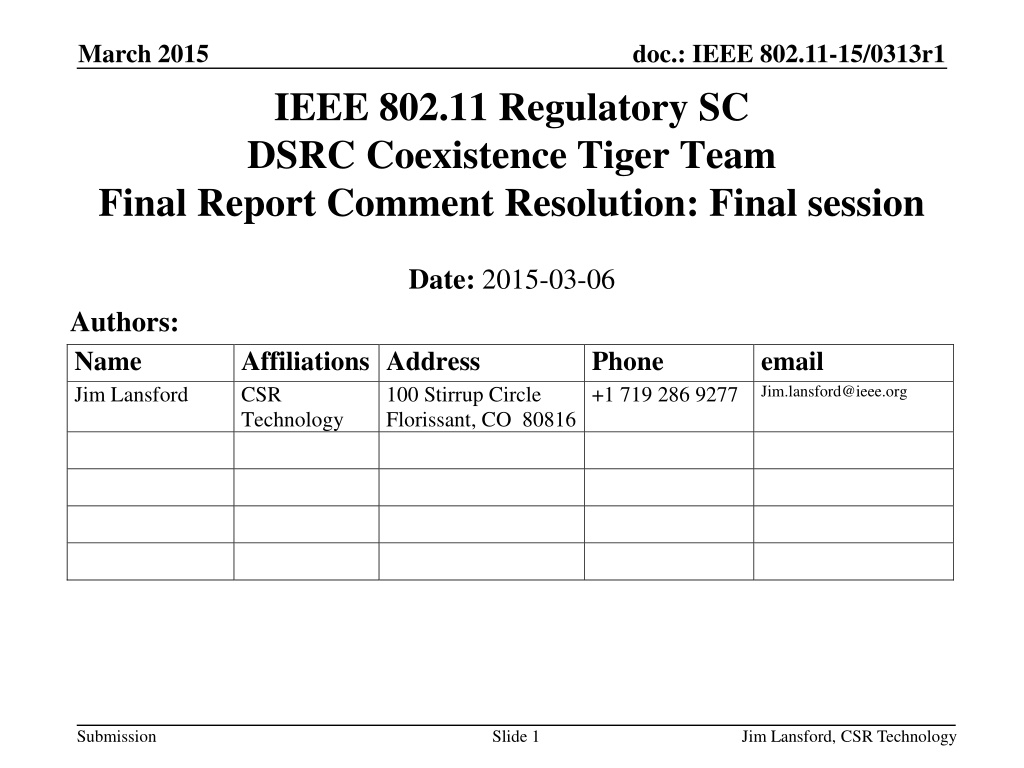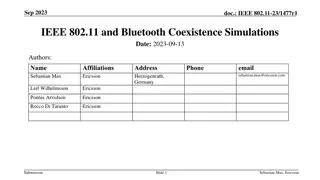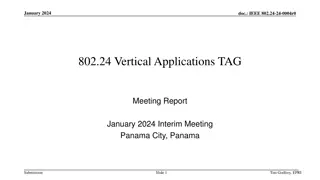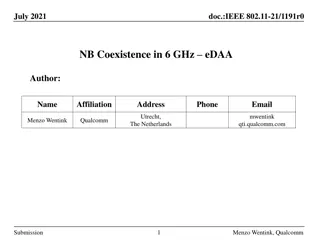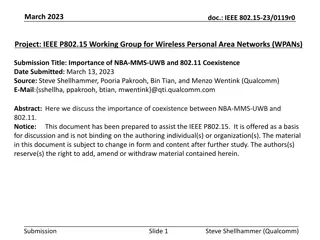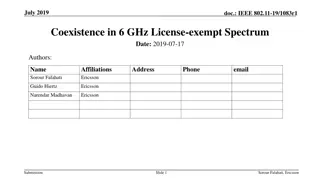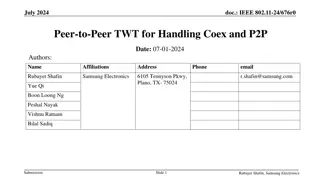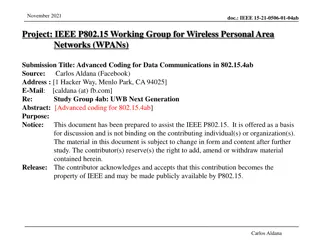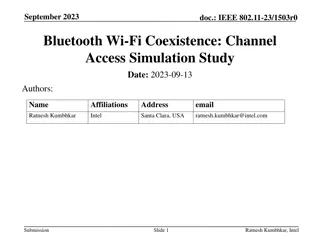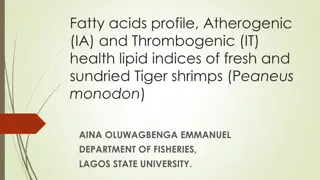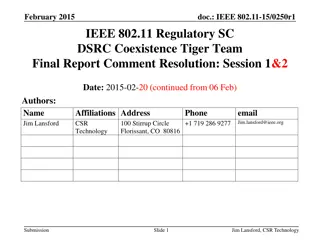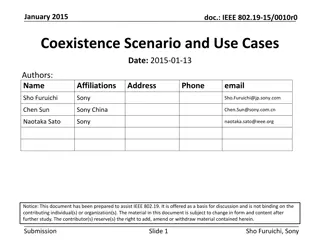IEEE 802.11 Regulatory SC DSRC Coexistence Tiger Team Final Report
Final report discussion on DSRC coexistence issues within the IEEE 802.11 regulatory framework, addressing proposed modifications and concerns raised by ITS interests regarding band sharing between Wi-Fi and DSRC systems.
Download Presentation

Please find below an Image/Link to download the presentation.
The content on the website is provided AS IS for your information and personal use only. It may not be sold, licensed, or shared on other websites without obtaining consent from the author. Download presentation by click this link. If you encounter any issues during the download, it is possible that the publisher has removed the file from their server.
E N D
Presentation Transcript
March 2015 doc.: IEEE 802.11-15/0313r1 IEEE 802.11 Regulatory SC DSRC Coexistence Tiger Team Final Report Comment Resolution: Final session Date: 2015-03-06 Authors: Name Jim Lansford Affiliations Address CSR Technology Phone +1 719 286 9277 email Jim.lansford@ieee.org 100 Stirrup Circle Florissant, CO 80816 Submission Slide 1 Jim Lansford, CSR Technology
March 2015 doc.: IEEE 802.11-15/0313r1 Abstract Final comment resolution session on DSRC Coexistence Tiger Team Final Report. Submission Slide 2 Jim Lansford, CSR Technology
March 2015 doc.: IEEE 802.11-15/0313r1 Background Final report draft was posted as document 14/1596. Latest version is r3 https://mentor.ieee.org/802.11/dcn/14/11-14-1596-03-0reg-final- report-of-dsrc-coexistence-tiger-team.docx Comments on 14/1596r0 were collected and posted as document 15/175r4 (latest version) https://mentor.ieee.org/802.11/dcn/15/11-15-0175-04-0reg-dsrc- coex-tt-final-report-consolidated-comments.xls CID number is row number in this spreadsheet This document has the highest priority comments that still need to be resolved No additional time remains for comment resolution after this call today Slide 3 Submission Jim Lansford, CSR Technology
March 2015 doc.: IEEE 802.11-15/0313r1 CID resolution 1/4 Page Num ber Line Numb er Subcl ause Must Be Satisfied Proposed Resolution CID Comment Category Proposed Change Another proposal that has been made in the group suggests modifications to the existing far more significant changes to DSRC[18][19]; it would revamp the existing band plan as defined in the FCC Report and Order 03-324 and allows unlicensed devices such as Wi-Fi to share only the lower 45MHz portion of the band, while reserving several channels at the top of the band exclusively for the use of DSRC safety-related systems. The report of the group should avoid characterizing the proposals at issue with adjectives like "far more significant." Revision reflects more neutral language. Revision also provides additional clarity about the nature of the Qualcomm proposal. It is important to note that these are concerns raised by ITS interests and are not in all cases shared by Wi-Fi interests. 64 245- 249 General 7-8 Yes Accept Accept but - Change to: "Some Tiger Team members suggested there are" . (R3) 62 General 7 228 There areITS interests voiced Yes Submission Slide 4 Jim Lansford, CSR Technology
March 2015 doc.: IEEE 802.11-15/0313r1 CID resolution 2/4 Mus t Be Sati sfie d Page Num ber Sub clau se Line Num ber CID Comment Category Proposed Change Certainly some aspects of the existing tests, such as upper layer messaging (parts of P1609 and J2735), would still be relevant, but ITS interests state that the potential for new forms of co- channel interference, adjacent channel interference, and congestion would mean that portions of the testing would have to be re-done. Proposed Resolution Again, it is important to clarify which views are held by only one group and which views are shared by the group. 68 General 8 264 Yes Accept Modified accept - proposed alternative: On the other hand, the objectives of this proposal were to provide protection for BSM traffic because they would not have to share with Wi-Fi at all, and to allow modified 802.11ac chipsets to be used with 160MHz bandwidth channels to span from U-NII-3 into the new (shared) U-NII-4 band. On the other hand, this proposal would maximize protection for basic safety messages and other safety-of-life ITS applications because they would not have to share with Wi-Fi at all, and it would allow existing 802.11ac chipsets to be used with 160MHz bandwidth channels to span from U-NII-3 into the new (shared) U-NII-4 band. More fully and accurately describes what the Qualcomm proposal would accomplish. 69 269- 271 General 8 Yes Submission Slide 5 Jim Lansford, CSR Technology
March 2015 doc.: IEEE 802.11-15/0313r1 CID resolution 3/4 Without the edit, this sentence is speculative; at this early stage, one should not make assumptions about what would or would not be cost effective for particular categories of unlicensed devices. From a practical perspective, non-Wi-Fi devices would likelymay not find adding this CCA mechanism cost effective, so sharing based on CCA-detection would likely be limited to Wi-Fi devices. 218- 220 60 General 7 Yes Accept No change to IEEE spec is necessary. Remove the last sentence in Section 10. 94 Accept Insert the following sentence before the sentence that begins "Finally": Another distinction with DFS is that under the 13- 0994 proposal every STA that wants to use the U-NII-4 band performs DSRC detection; there is no master or client role as there is in DFS." The comparison of 13-0994 with DFS does not note that in 13-0994 every STA performs detection. There is no master- client role. 19 Technical 9 84 Yes Accept with edits Accept - but only refer to the document without going into detail. See CID 57. This could also go in Section 4. We requested some information from DSRC industry in IEEE 802.11-14/0819r0. This fact needs to be emphasized by referring to the presentation document. Best place for referencing 14/0819 is Section 12 Technical 8 12 95 Submission Slide 6 Jim Lansford, CSR Technology
March 2015 doc.: IEEE 802.11-15/0313r1 CID resolution 4/4 Accept - but cite 14-1101/r1 was presented to the group, state that the submission had 28 supporters, and that the submission states that the 13/1449 proposal is a viable band sharing mechanism. Accept - the issue is that the 13/1449 proposal uses 20MHz CCA in three channels, which is consistent with existing 802.11ac chipsets. The 13/0994 proposal would require seven 10MHz CCA detectors, which is not part of the existing specification or in existing chipsets. The Tiger Team has a submission that provides a critique of the proposal discussed in section 10. This submission should be cited, and the high level critique should be noted Cite 14-1101/r1, including basic dimensions of critique and conclusion that the proposal is not viable as a sharing technology 27 Technical 10 Yes The statement at the end of section 10 seems contradictory to the statement in issue 1 of section 9. In section 9, changes to secondary detection are described as extensive. Here they are described as "likely not result in major change to existing standards or chipsets." The phrase "are not causing harmful interference to DSRC systems" points to one shortcoming of the work to date, at least to my knowledge. I think before any sharing scheme could be accepted, there would need to be a quantification of what constitutes "harmful interference." Is the loss of on Basic Safety Message harmful? 1% of BSMs? I don't recall this being discussed in the TT, but this point might be worth mentioning. Similarly, the "satisfactory" performance in line 251 may depend on who is reading the test results. Technical 8 See 15/0175r5 spreadsheet Modify the language in Sections 9 and 10 so it is consistent. 29 Technical 10 44 See 15/0175r5 spreadsheet Add a sentence: "Additionally, a determination will need to be made as to what threshold of interference is considered "harmful" to DSRC operation' or similar. 83 12 243 Yes Accept Submission Slide 7 Jim Lansford, CSR Technology
March 2015 doc.: IEEE 802.11-15/0313r1 Conclusion Any comments not addressed on this call will be resolved using the proposed comment resolution contained in spreadsheet (15/0175r4) Some additional editorial revisions to improve consistency and readability may be made before the final version is posted. Submission Slide 8 Jim Lansford, CSR Technology
